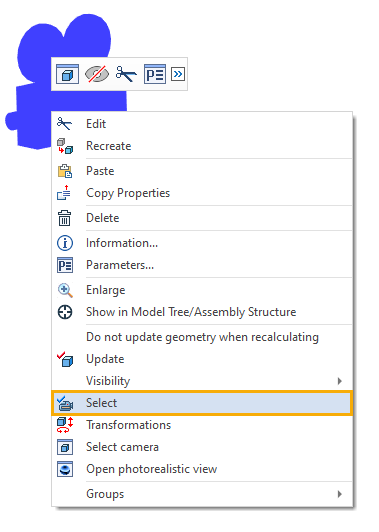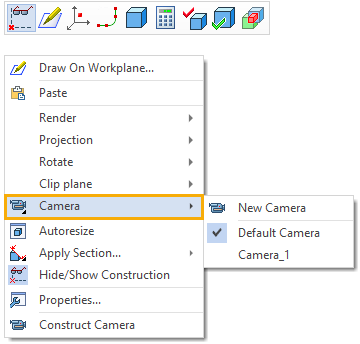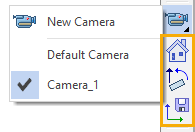Select Camera as Active One |
  
|
Calling the command:
Icon |
Ribbon |
|---|---|
|
View > 3D Model > Select Camera |
Keyboard |
Textual Menu |
<3VC> |
View > Camera |
After calling this command, a dialog window will appear containing a list of all cameras present in the 3D scene. It is necessary to select the camera from which the 3D scene will be reviewed.
The second way to select a camera as active is available when the system is in command standby mode: you can move the cursor to the camera in the 3D window and press ![]() and select Select from the menu that appears.
and select Select from the menu that appears.

The camera can be selected from the context menu called by clicking ![]() , when pointing the cursor to a free field of the 3D window.
, when pointing the cursor to a free field of the 3D window.

Also, camera selection is available from the model tree.
Sometimes, when choosing a camera as the active one, the view obscures the image of the LCS, on which the camera was created. In this case, you can hide the LCS using the corresponding icon from the model tree.
If you set the presence of two 3D windows on the screen (using the Split Vertically command), then in the second 3D window you can observe the movement of the selected camera from the system camera.
If the camera is used in any 3D view, it cannot be selected. You can create a camera and set its parameters in the Create Camera command. You can change existing cameras and their parameters in the Edit Camera command.
Controls in active camera mode:
Note! Controls for the perspective camera are described below. Result of the key combinations usage may differ for the parallel camera, because of the parallel projection properties.
•![]() - camera rotation.
- camera rotation.
To eliminate rotation around view axis you need to activate Panorama ![]() mode.
mode.
•Arrow keys allow to move camera forward/backward.
•Page up/Page down keys allow to move camera up/down.
It is recommended to disable object snap ![]() on View toolbar upon movement in selected camera mode.
on View toolbar upon movement in selected camera mode.
•![]() +<Ctrl> – movement in the screen plane.
+<Ctrl> – movement in the screen plane.
•![]() +<Shift> – zoom.
+<Shift> – zoom.
•![]() +<Alt> – rotation around vertical axis.
+<Alt> – rotation around vertical axis.
•![]() +<Ctrl> – mode of smooth move forward/backward. Movement speed changes according to the cursor position.
+<Ctrl> – mode of smooth move forward/backward. Movement speed changes according to the cursor position.
A cross will appear on the screen that will become the reference center for the direction vector (the vectors are not displayed). The motion occurs in the following way: moving the pointer by the mouse with the button depressed upward from the cross moves the camera forward. Moving the pointer downward from the cross will move the camera backwards. Moving the pointer in the horizontal direction right or left of the cross will make the camera rotate about its vertical axis right or left, accordingly. Moving the pointer along a diagonal with horizontal and vertical components (see the diagram) will make the camera both move in the respective direction and rotate. Note that, depending on the pointer's bias to one or the other main vector, the translation or else the rotation will dominate to some degree. The farther the pointer is moved away from the cross, the faster the camera will move.
|
1. Backward 2. Forward 3. Rotation around its vertical axis to the left 4. Rotation around its vertical axis to the right 5. Forward with a turn to the right side |
•![]() – zoom: move the camera forward/backward.
– zoom: move the camera forward/backward.
•![]() +<Ctrl> – zoom: perspective angle changed without camera movement.
+<Ctrl> – zoom: perspective angle changed without camera movement.
Long press left mouse button (until the cross symbol appears) – orbital rotation around the selected center. The center is selected using the existing in the scene geometry.
Special 3D - User camera tab in the Document Parameters dialog is used for camera management.
Active Camera Options
Additional options for camera are available on the View toolbar after selecting camera as active.

Options available when camera is active:
Restores last saved position and orientation of the camera.
![]() Reset camera vertical orientation
Reset camera vertical orientation
Restores last saved orientation of camera's vertical axis.
|
|
|
Initial position and orientation |
Position and orientation |
Position and orientation |
![]() Apply current transformations to camera
Apply current transformations to camera
Saves current position and orientation of the camera. If you didn’t activate the option after movement/rotation of the camera, the camera will return to the initial state after exiting active camera mode